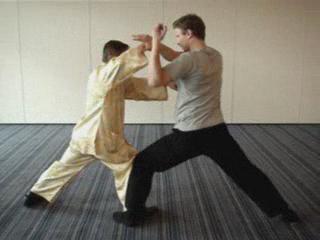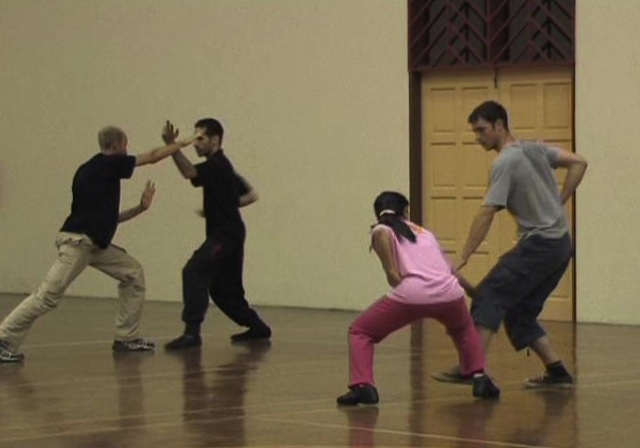CHANGING OPINION AND UNDERSTANDING IN XINGYIQUAN

Xingyiquan -- kungfu for generals
Question
In preparing to teach the Xingyiquan course, has your opinion/understanding of the art changed? If so, in what ways? Can you take us through your process for preparing to teach the Xingyiquan course?
Sifu Matt Fenton
Answer
Yes, in preparing myself to teach Xingyiquan, both my opinion and understanding of Xingyiquan have changed much. The process of change is as follows.
I knew that Xingyiquan was simple, and was regarded as kungfu for generals, but I did not realize why it was so. After preparing myself thoroughly to teach it, which included researching into all the resources I could get on Xingyiquan and practicing it according to the accumulated information, I have an in-depth understanding as well as practical experience why it is so.
At first I thought that Xingyiquan was simple because it was based on only five elemental fists. Hence, Xingyiquan practitioners had to compensate their limited techniques by adding Taijiquan and Baguazhang to their training. But my study of Xingyiquan has shown that Xingyiquan is complete by itself. There is no need to add any art to it.
This realization was much helped by my earlier preparation in teaching Wuzuquan. Indeed, there are many things similar between Xingyiquan and Wuzuquan.
My study of Xingyiquan has led me to realize that its simplicity is not due to its inventor lacking in techniques, but due to his reducing the numerous techniques he already knew to a few fundamental ones.
This is an important concept, and will become clearer if we quantify it. Suppose a martial artist progresses from 1 to 100. The simplicity of his art occurs not at 10 when he has 90 more to learn, but it occurs after he has completed 100 and reduced the numerous 100 to a few fundamentals. It is worthy of note that the inventer of Xingyiquan was Marshal Yue Fei, who is deified as the God of Martial Art.
This realization gives me a better understanding why Xingyiquan is regarded as kungfu for generals, whereas Eagle Claw Kungfu, which was also invented by Yue Fei, but has many sophisticated techniques, is regarded as kungfu for ordinary soldiers.
At first I thought that Xingyiquan, being simple, needs tremendous internal force in order to be applied effectively in combat, and generals rather than ordinary soldiers would have the mind-set to train internal force, which is relatively more boring and more demanding than learning techniques.
But the realization mentioned above now makes me think otherwise. It is not because the generals did not know a lot of combat techniques that they practiced Xingyiquan, it was precisely because they knew a lot of combat techniques that they could use Xingyiquan, with its few techniques, effectively.
As an analogy, it is not because a master mechanic has not been trained to use a variety of tools; it is precisely that he has been trained to use many different tools that he can now use just one simple tool effectively. Apprentices would have to spend time learning various tools.
Similarly, it was not because Yang Lu Chan did not know many Taijiquan techniques that he only used Grasping Sparrow's Tail in his fighting. It was precisely because he knew many Taijiquan techniques that he could effectively use just Grasping Sparrow's Tail to defeat all challengers. Taijiquan students who wish to be combat efficient would have to spend time learning the many Taijiquan techniques.
Attending the Intensive Shaolin Kungfu Course or the Intensive Taijiquan Course where a comprehensive and in-depth understanding and application of all important kungfu aspects are provided will enhance the accomplishment in Xingyiquan, or any kungfu style, in many ways. Among many benefits, you will learn how to cover yourself adequately for safety first, and how to keep pace effectively with your opponents as they retreat -- two skills which Xingyiquan practitioners may not perform efficiently if they do not have proper foundation.

Eagle Claw Kungfu
The combat application of Xingyiquan is marvelous, especially against modern day fighters. Initially I thought that Xingyiquan exponents use their tremendous force to bull doze into their opponents. My study shows that while they press in relentlessly at their opponents, they cover themselves adequately adhering to the principle of safety first.
Let us examine some scenarios of you fighting an opponent in a free sparring competition.
As soon as he moves in to attack you, or even before he makes the first move, you move in swiftly with a pi-quan, or palm-thrust, covering yourself adequately in your attack. In other words, instead of you worry how to defend yourself against his Kick-Boxing or MMA attacks, you pass the burden back to him right at the start.
All his responses can be classified into the following four possibilities:
1. He is taken aback and does not know what to do, in which case you continue to overwhelm him with a series of pi-quan.
2. He bounces away or retreat, in which case you close the gap immediately and overwhelm him with your series of pi-quan.
3. He wards of your attack and is about to counter or is hesitant on what to do next, you slip away your attacking hand, cover him adequately with your other hand, and overwhelm him with your series of pi-quan attacks.
4. He neutralizes your attack or counter attack immediately, regardless of whether he does so skillfully using no-defence-direct-counter or he sacrifices himself and meet your attack head-on to counter attack, you neutralize his counter and immediately continue to press him with your series of pi-quam.
This strategy is bafflingly simple. You just use one technique in a sequence to press in relentlessly. It is even better than the strategy I used in my young days when I sparred with many martial artists and remained undefeated. You can use techniques from other kungfu styles for this strategy, like the Black Tiger of Uncle Righteousness, but the nature of Xingyiquan makes this strategy most effective.
In today's low level of sparring, where combatants generously exchange blows, more than 80% of combatants fall under the first three categories. Of the 20% in the fourth category, 15% use straight-forward punches and kicks in their counters. Only 5% are capable of using sophisticated techniques like felling and chin-na.
Hence, if you just practice a series of pi-quan 30 times daily for three months, taking care to cover yourself adequately in your attack, you will beat 80% of the combatants in today's free sparring competitions! If you also spend some time to respond efficiently to surprised or die-hard counters of punches and kicks, you will be able to defeat 95% of your opponents. You can easily give yourself three months to test whether this statement is true.
How would you respond to the 5% of sophisticated counters, like felling techniques and chin-na? In the past, where the standard of fighting was higher, the percentage was also higher.
You don't have to borrow techniques from Taijiquan or Baguzhang or any other styles. You can use techniques from the 12 animal-forms of Xingyiquan, or even from the basic 5 elemental fists themselves if you are skillful.
Suppose your opponent grips your pi-quan with a double-hand chin-na, you can release the grip and simultaneously kick him with a dragon-form. If he attempts to fell you, you can neutralize his leverage advantage, grip his hands away and strike him with double tiger-palms.
If he grasps your neck and executes a Muay Thai knee jab, you can deflect his grasp and knee jab and strike his groin or fell him with a snake-form. If he shoots in for a take-down, you can break his arms or elbows and strike him with double fists using an ostrich-form.

Intensive Shaolin Kungfu Course
Xingyiquan Questions and Answers
The questions and answers are reproduced from the thread 10 Questions to Sifu about Xingyiquan in the Shaolin Wahnam Discussion Forum.
LINKS
